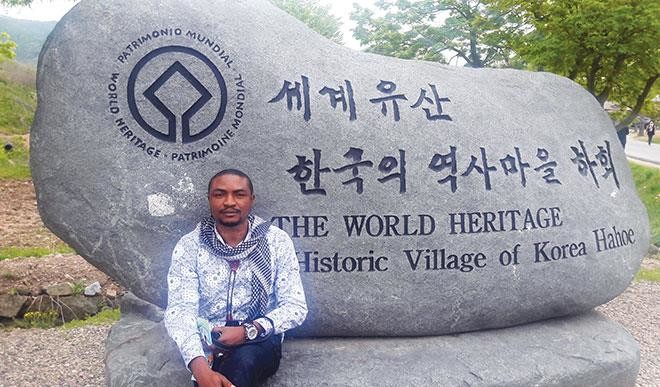
In South Korea for the Journalists Forum for World Peace, this reporter visited the historical village of Hahoe, in Andong Province, which is 500 years old and has been preserved in its original state. It is now a UNESCO World Heritage Site and draws in thousands of tourists yearly who come to explore the sites and the spiritual connotations at the heart of this village.
There are wooden gods scattered here. Faces carved into logs that have been erected at the entrance of the historical village of Hahoe, which is reputed to be some 500 years old. These gods in ruins are the ancestral deities charged with the task of protecting this little farming and fishing village. A responsibility they have been saddled with since the village was established in the 16th century Joseon Dynasty.
Going by this, it becomes clear that Hahoe was established, and has been preserved, with the Korean essence of spirituality and discipline at heart. And it was here that some famous Koreans were born; brothers Ryu Unryong and Ryu Sengryong being the most well-known. The former was a great Confucian scholar of the Joseon Dynasty and has the honour of being represented on a Korean banknote, while the latter was the prime minister during the Japanese invasion of 1592 to 1598.
How Hahoe survived the times, and especially Korea’s 1970s housing whirlwind that saw the government bulldozing most villages and replacing them with urban sky-rises, constructs that are now drab-looking 1970s architecture, is something muted in conversations.
Koreans owe this to a descendent of the famous Ryu clan, who established the village. The businessman, who happened to be a powerful arms manufacturer in the 1970s and enjoyed the confidence of the Korean president at the time was said to have persuaded the president to spare Hahoe from mordernisation. He made a convincing argument and the president struck Hahoe off the list of villages to be demolished.
Four decades later, in 2010, Hahoe, with its straw and tile roof structures in traditional Korean architecture was declared a World Heritage Site by the United Nations Cultural Heritage by the United Nations Educational, Scientific and Cultural Organisation (UNESCO).
With Mount Hwa hedging the village from the east, and the River Nakdong curling around it like a snoozing serpent in the shape of the letter S, Hahoe (which translates as River Bend or River Meander) is thought to be a good place to live. These geographic features have led to connotations that Hahoe looks like the yin-yang on the Korean national flag – a statement that carries some spiritual potency. It has also been suggested that the village, cradled between the river and the mountain, looks like a lotus flower floating on water.
Remarkably, the houses in Hahoe are not just an open-air museum relic, they are actually inhabited by the over 200 people who still call this village home. For the inhabitants, the fame of their village has been a mixed blessing. While the government pays them to maintain their houses in pristine conditions, the influx of tourists has been nothing short of an invasion, of their privacy at least, with tourists often peeking over low fences to catch glimpses of what the interiors look like, stealing glances at the inhabitants through half opened doors.
“They don’t like tourists that much,” the guide explained, smiling almost apologetically.
Most of these inhabitants are old, practising traditional occupations like agriculture, as their forefathers had done before, and if not for their modern clothing, one would have thought he had travelled back in time some five centuries at least.
The tile-roofed houses belonged to the nobility. They were the ones who could afford baked tiles from which the famous curved roofs of traditional Korean architecture are fashioned, something that is distinct to Asia.
Evidence of the superstitions and spirituality at the heart of the village is planted even in the architecture, on the engravings on the roofing tiles, on inscriptions on door panels. But curiously even the houses of the nobles have mud fences – or used to have mud fences, which are often topped with roofing tiles to prevent the rain from washing them away.
There was a reason for this as the superstitious villagers believed their canoes would be doomed if they are passed by concrete or stone fences.
But now that most of the villagers have outgrown their dependence on canoes, it is not uncommon to see stone walls, topped with tiles, in the traditional fashion replacing the old ones.
In the midst of Hahoe, right in the centre of the village is a glorious looking zelkova tree with some impressive proportions. The tree called Samsindang is reputed to be at least 600 years old and is thought to be the abode of the goddess Samsin. Here too, there is a carving, like the gods scattered at the entrance of the village, planted prominently before the tree, which is surrounded by strings upon which prayers, scribbled on papers are hung, forming a blind of prayer papers.
The goddess Samsin is thought to have powers over pregnancy, child birth and fostering. In other words, she is the goddess of fertility.
With the tree at the centre of the village, most houses in Hahoe take the liberty to be built facing the river or the mountains, unlike most houses in Korea, which are built to face the South or Southeast.
But with the decline of religious beliefs in Korea, with about 50 percent dissociating themselves from any religious belief, Sam sindang may in the nearest future serve only historical and aesthetic purposes in the village. And maybe the commemoration tree, Queen Elizabeth had planted in the house of one the nobles, may have acquired more prominence by then.
Walking back towards the entrance, this time through the pine forest bordering the village on one side, one is filled with the serenity that the residents of this village would otherwise enjoy on a normal day. The Mansongjeong Pine Forest is reputed to contain about 6,000 pine trees, but even a cursory look will reveal that this figure is greatly exaggerated. The forest was planted to compensate for the exposure of the village to the wind as there are no natural features providing cover from that side.
With the forest on your left, one can see the folk play yard, equipped with traditionally built swings and seesaws, where children of the ancients had probably played and fought; where children of the village still play.
If one had boarded the ferry and crossed to the other side of the river, one would have seen the famous Hwacheon Confucian Academy as well as the Gyeoman Pavillion.
Intangible Heritage
Some 200 metres from the entrance, where the wooden gods stand guard, there is an open air theatre. It is here that Hahoe’s intangible heritage is preserved. In the old days, the Byeolsingut Mask Dance used to be an avenue for the commoners to make fun of the nobility by wearing masks and performing satirical plays.
The masks are carved with 11 expressions, some more famous than the others, but all intended to conceal the identity of the wearer so as to capture without fear, the folly of the nobility of the times.
Now the masks have become famous symbols of Hahoe and are sold as souvenirs to the visitors of the village.
At the theatre, there are actors who still enact the plays, which like most satires are characterised by caricatures, exaggerated comical movements and dances before a large audience that knows it is witnessing something rare and historic.
Korea is a country that has grown tremendously in the last few decades, but it is here in Hahoe, the historic village of Korea, that some of its essence is preserved, where a traveller feels like he has travelled several centuries back in time.

 Join Daily Trust WhatsApp Community For Quick Access To News and Happenings Around You.
Join Daily Trust WhatsApp Community For Quick Access To News and Happenings Around You.


